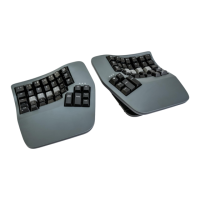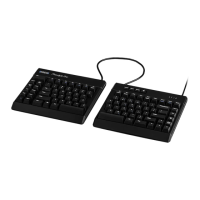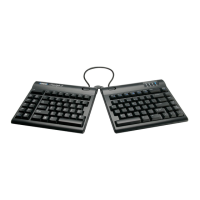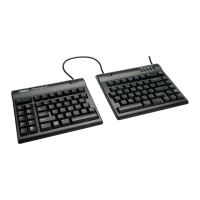35
custom actions have been saved to the QWERTY Layout, then the qwerty.txt le will be blank.
2. dvorak.txt– The dvorak.txt le contains the conguration instructions for the default Dvorak Layout. Only custom
remaps and macros created in (or otherwise assigned to) the Dvorak Layout will appear in the dvorak.txt le. If no
custom actions have been saved to the Dvorak Layout, then the dvorak.txt le will be blank.
3. do_not_edit.txt- ?????
4. state.txt– The state.txt le contains and displays information about the active settings of the keyboard. In general this
le should not be deleted or altered and should be used only for reference when the Status Report function in
inconvenient.
Note: If you wish to have the V-Drive enumerate every time your computer boots up, you may insert and
save the following line of case-sensitive text to the state.txt le: “v_drive_open_on_startup=ON”.
5. version.txt– The version.txt contains information about the rmware currently running on the keyboard. This le
should not be deleted or altered, and should be used only for reference when the Status Report function in inconvenient.
Note: If you have created custom hotkey layouts you will see additional .txt les in the Active Folder, one for each hotkey
layout you have created. Hotkey layout les are based on either the underlying QWERTY or Dvorak Layout and are named
so that the hotkey assigned to trigger the layout appears before the base layout. For example, a QWERTY hotkey layout
assigned to trigger key Q will be named “q_qwerty.txt” and Dvorak hotkey layout assigned to trigger key 5 will be named
“5_dvorak.txt”.
Creating a Hotkey Layout (PUM Required) Program + F2
A Hotkey layout is an alterative layout, based either on the default QWERTY or Dvorak layouts, which can be used to store
custom macros and remaps. Hotkey layouts are accessed through a convenient key combination that you select. QWERTY
and Dvorak hotkey layouts are saved separately, and the same hotkey can be assigned to trigger a different layout for both
QWERTY and Dvorak.
To create a hotkey layout, rst enter Power User Mode (Program + Shift + Esc). Then hold Program and tap F2. The Num
Lock LED will begin ashing rapidly, prompting you to select a “hotkey” that you will use to access your new hotkey layout.
Only alphanumeric keys can be used activate a hotkey layout. Tap the desired hotkey and the LED will stop ashing.
Note: If you attempt to create a new hotkey layout assigned to a key which already has a hotkey layout for that layout

